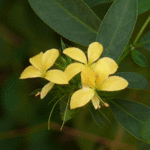10th March 2008 : Morphs & more early birds of 2008
 Sunday, March 9, 2008 at 10:10PM
Sunday, March 9, 2008 at 10:10PM
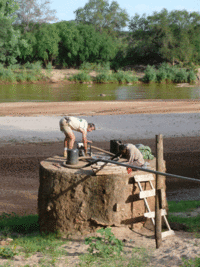
Pumping water is a palaver...here are Ian and Pius on our well...
Click any image to enlarge

Sometimes it all gets a bit too much!
The irony of us living by a river is that water is our greatest challenge. We are 15 miles from the nearest water mains, which means we have to be completely self-sufficient when it comes to our water needs. We alternate between pumping from our well and pumping direct from the river, depending on where the river is (the course changes so much from week to week), how clear the water is (when in flood the river is very muddy), and how much water is seeping into our well. It’s practically a full time job trying to keep enough water in our tanks for our day-to-day use, and one which drives Ian a little bit crazy from time to time…such as this morning, for example: we returned late last night from Nairobi, only to find our water had run out. I’ve been bathing from a bucket today, splashing around, a bit like one of the birds in our birdbath.
Speaking of birds, I am aware that I have been somewhat remiss on the blogging front of late, as I have been been so busy, and many bird-and-beast tales have been missed out. So, I am going to try to do a quick “creature catch-up” over the next few days, starting today with this bird journal, recording some highlights of my avian sightings so far this year.
Around the Kulafumbi area, we get a few morphs amongst our birds – one being the Purple-banded Sunbird which here in Tsavo (somewhat confusingly) has no purple, maroon or violet on it at all (nectarinia bifasciata tsavoensis). Another morph we observe here (though it is by no means the norm, so is always the subject of conversation when seen), is a white-backed Bateleur Eagle, one of which is resident in this area. (Most Bateleurs have a rufous brown back.) You can always tell a Bateleur, even from a distance, by the distinctive up-turned shape of its wings. Whether white-backed or not, the male and female birds can be distinguished from one another in flight as the male has a broader black edge to his wings. When perched, these eagles look ungainly and stocky, but they are in fact the ultimate aerial acrobats – their aerobatic displays take your breath away, as they tumble out the sky, male and female talons linked, or diving out of the blue at an incredible rate, then throwing their heads back and emitting their haunting cry…

White-backed Bateleur morph
Click any image to enlarge
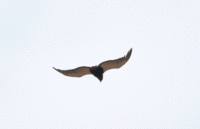
The distinctive upturned wing shape...
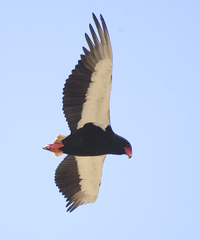
A beautiful Bateleur male - photo courtesy of my husband Ian
African Paradise Flycatchers are also prone to morphing in this part of the world. Sometimes these striking, normally chestnut coloured birds, with their blue eye-wattle, black heads and, when breeding, long chestnut tails, are instead snow-white. We often see a handsome white male flitting across the road as we drive to Mtito Andei (our nearest town), his long tail like a magic wand wafting behind him.
In mid January, I started seeing some Paradise Flycatchers around the house. One looked like it was a subspecies (terpsiphone viridis ferreti), because of its shorter-than-normal tail and white flashes on the wing. Another one looked almost like it was half way between the white morph and the short-tailed subspecies…it’s hard to keep up with exactly what’s going on with these birds!
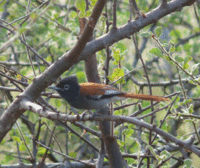
A shorter-than-normal tailed Paradise Flycatcher
Click any image to enlarge
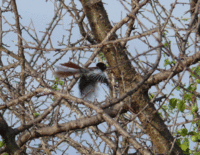
More white than chestnut on this chap...
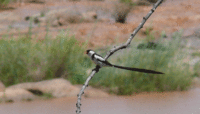
Pin-tailed Whydah, male in breeding plumage (being blown about in a strong wind!)
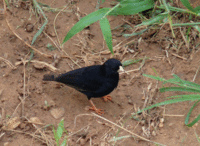
African Indigobird (male)

Grey Hornbill in the bushes by our bedroom
Another long-tailed bird that we have seen around the house recently is the breeding male Pin-tailed Whydah. This is another extraordinary bird (quite dull when not breeding), which is unmistakable in its black and white breeding plumage and bright red beak. These birds are known to parasitize the nests of other birds, so it’s no surprise the male Indigo Bird was chasing the Whydahs away across the river at every given opportunity. They also compete for the same food source, both being seed-eaters, attracted to the seeding grass on our Hippo Lawn (which is still not attracting any hippos, in case anyone is wondering.)
The Grey Hornbills are also getting a lot tamer, and we often see them in the bushes and trees right by the house. In time, they may come to our bird table. A pair of Speckled Pigeons (which normally nest on cliff ledges) turned up at the house and starting scouting around for nesting sites. They had a good look under our eaves, and up on the roof, but after a few days they disappeared and we have not seen them since – what a shame – how lovely it would be to have a pair of these pigeons nesting and cooing in the house somewhere. Who knows, they may come back…
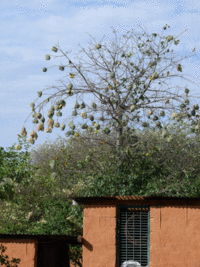
Second round: Village Weavers nesting above our stores for the second time this year
Click any image to enlarge
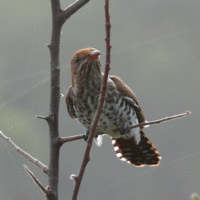
Diederik Cuckoo fledgling
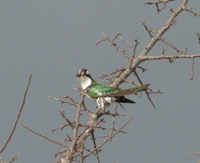
Adult Diederik Cuckoo
There have been a lot of young birds about, evidence of a successful nesting season. The Village Weavers even embarked on a second round of nesting this year, as the rains persisted longer than usual, which also kept the thieving Diederik Cuckoos interested – they are always on the lookout for nests which they can parasitize, laying their eggs in the nest of another bird, which then unwittingly proceeds to incubate the eggs and carry out all the hard work of feeding the chicks when they hatch. To prove a point, the young Cuckoos could be seen begging from their surrogate Weaverbird mothers in the bushes around our house. They may be rather stunning birds, with their electric green plumage and fire-red eyes, but the Diederik Cuckoos are not the friendliest of birds – no sooner were the fledglings (lovingly raised by the weavers) out of the nest, than they were being hounded by their adult brethren.
Young Diederik Cuckoo begs from its surrogate mother, a Village Weaver
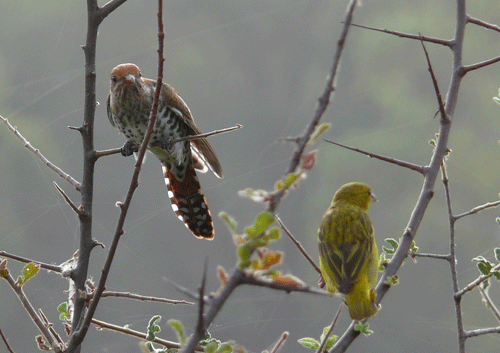
Fledging sunbirds have also been appearing – sweet little pompom-esque creatures, perched tweeting in the bushes awaiting sustenance from their parents. Young Barn Swallows have been perching on the wispy acacia thomasi branches, joined intermittently by a flock of adults. At the end of February, my father saw a pair of Crested Francolin with a clutch of tiny, newly hatched chicks down near our gate, but as yet I haven’t managed to locate them with my camera.

A baby Sunbird, chirping for its parents
Click any image to enlarge
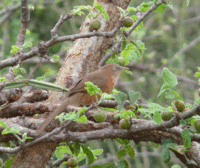
A young Rufous Chatterer in the thicket to the left of our house
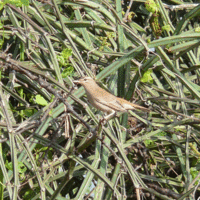
In the very same thicket, a Rufous Bush Chat, flicking its rufous tail up and down - a characteristic habit of this bird
I was alerted to the presence of a young Rufous Chatterer by its piercing supplications from the bush to the left of our verandah – adding another new bird to our Bird List, now numbering 177+++. Early in February, the same bush delivered up another newcomer to the list, a Rufous Bush Chat (aka Rufous Scrub Robin, cercotrichas galactotes).
In fact, the thicket to the left of our house has been the stage for many a bird sighting this year. Two Yellow-vented Bulbuls, almost impossible to photograph in amongst the twigs and branches, were courting, displaying to each other with wings wide open and flapping, and ending with an equally dynamic mating ritual.
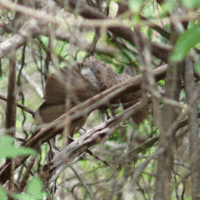
Bulbuls courting
Click any image to enlarge
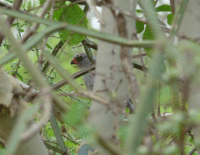
Gabar Goshawk hunting in thicket to the left of our house
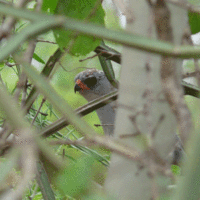
Gabar Goshawk close-up
The very same day in the very same thicket, I watched a handsome Gabar Goshawk hunting in amongst the tightly-twined branches, its eagle-eyes searching for smaller birds or lizards. Compare this with the equally good-looking juvenile Pale Chanting Goshawk (below), which I saw in Tsavo West at the end of January, posing in a tree right by the road. (I saw him in the same spot several times, just waiting for his photograph to be taken – or so it seemed.)

Tsavo West delivered up some other wonderful bird sightings too, including some common birds which I had as yet failed to photograph properly: the somewhat comical Yellow-necked Spurfowl, the painterly Helmeted Guineafowl, and the colourful European and Lilac-Breasted Rollers, visiting in their dozens. The half-eagle-half-stork that goes by the name of a Secretary Bird is a frequent sight in the grasslands too, although my photograph here is less than impressive.

Yellow-necked Spurfowl on the road in Tsavo West
Click any image to enlarge
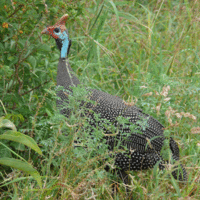
Helmeted Guineafowl
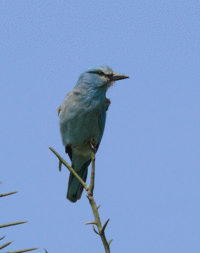
European Roller
Of course, it’s not just the brightly coloured birds which are beautiful – the ones with more muted, neutral tones are equally pretty, like these Black-faced Sandgrouse (below), poised for take-off in the middle of the road home to Kulafumbi.
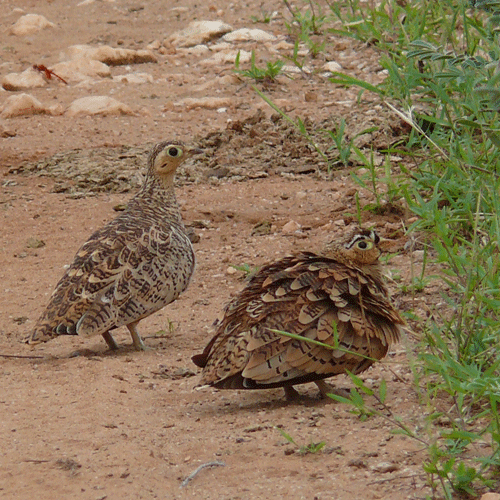
Back at the house, we’ve had other avian passers-by, including African Spoonbills, four of which flew by the house on the dull, grey morning of 17th February, and today a Yellow-billed Hornbill, which is wonderful, as they’re not as common as their Von der Decken and Red-billed cousins. The resident African Fish Eagles are still laying claim to this stretch of river, as are the less-than-pretty Marabou Storks, while the Glossy Starlings continue to make themselves at home, dominating the bird table. There is also a Yellow-billed Stork who seems to have found a favourite fishing spot right below the balcony and is always there beak-down fishing at sun-up.

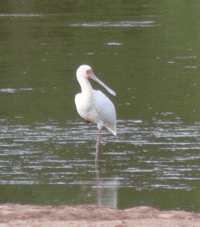
African Spoonbill stands on one leg at Hippo Bend
Click any image to enlarge
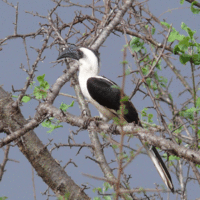
Female Von der Decken Hornbill
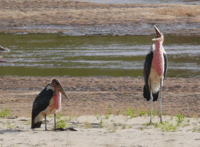
Early morning Marabous on the beach
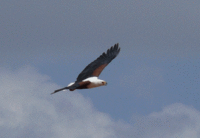
One of our resident Fish Eagles
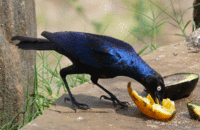
Glossy Starling tucking into some pawpaw on the bird table
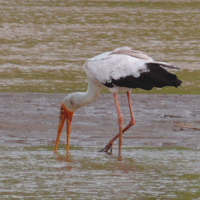
Constantly around these days: a Yellow-billed Stork fishing below the house
I saw a Red-fronted Tinkerbird in the bushes by our bedroom the other morning too, which I hadn’t seen so close to the house before. The Barbets, close relatives of the Tinkerbirds, are becoming more and more accustomed to the house too – I frequently hear a pair of Red and Yellow Barbets singing a duet in the thicket behind the house, and I managed to photograph a pair of the smaller D’Arnauds Barbets on one of my evening walks.
The Carmine Bee-eaters turned up for their annual visit on the 9th February, so indescribably stunning with their scarlet feathers, electric blue heads and scimitar tails. Unfortunately, none of my photos really do justice to the true colour of these incredible birds. I also recorded a Blue-cheeked Bee-eater on 24th January, another new arrival on the Kulafumbi Bird List.
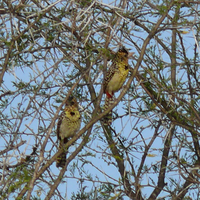
A pair of D'Arnauds Barbets
Click any image to enlarge

The extraordinary Carmine Bee-eater, seen here hunting for insects on the wing
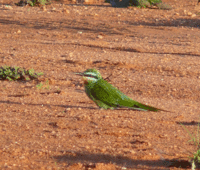
Blue-cheeked Bee-eater
The Red-billed Quelea have arrived. Famous for their huge flocks, numbering several million at a time as they start to congregate and breed when the grass turns green with the rain. From a distance these enormous flocks of tiny seed-eating birds resemble clouds of smoke: the most dramatic sight as they roll over the grass plains like massive airborne shoals of fish, or banking low over the river in the late afternoon light, their wings shining golden in the sun’s last rays. So far this year, the flocks on the river have been fairly small, but nonetheless they have been attracting the attention of hunting falcons as they come down to drink, massing on the reed islands before fluttering down to the water’s edge to quench their thirst, and attracting our attention as they bank and shimmer in the sun…
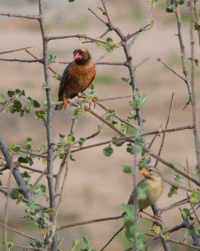
Red-billed Quelea pair: male top, female bottom
Click any image to enlarge
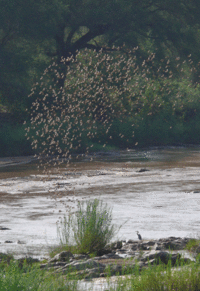
A flock of Quelea coming in to drink, above a silhouetted Grey Heron in the river
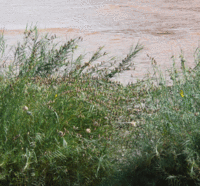
Weighing down the reeds with their combined weight
And to end on something completely different: Who's this looking in my office window?!
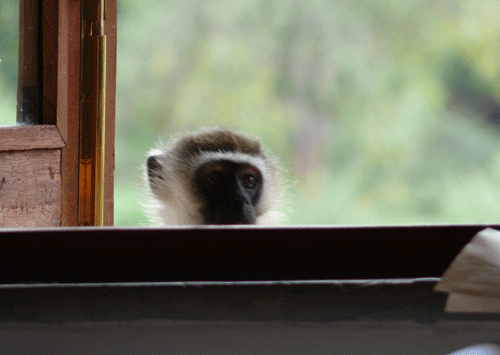
More Bird Pictures:
from January 2008
from February 2008



